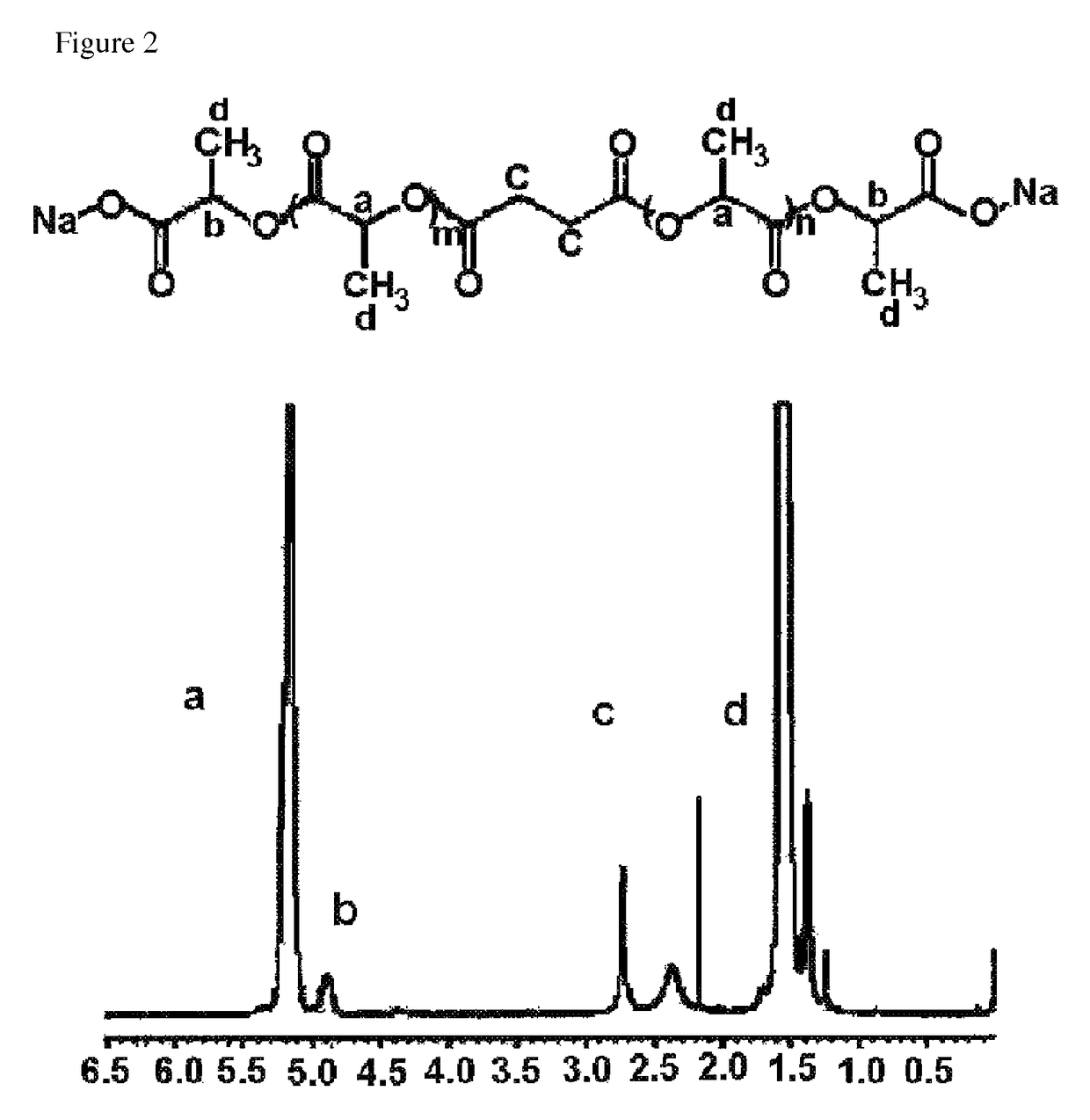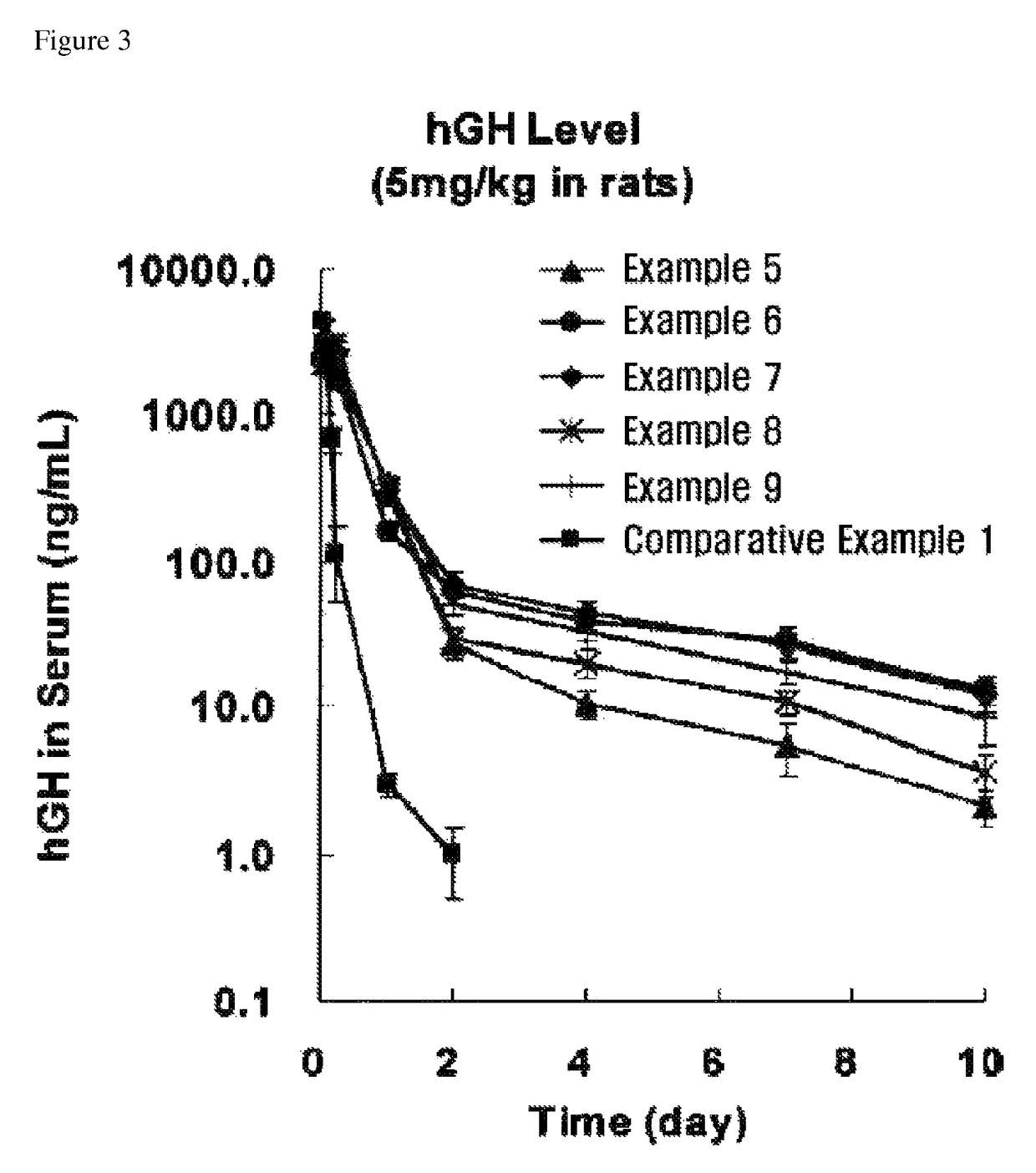Macromolecule for delivering protein, polypeptide or peptide drugs and a production method for the same, and a slow release composition for protein, polypeptide or peptide drugs and a production method for the same
a technology of protein and polypeptide, applied in the direction of peptides, drug compositions, metabolism disorders, etc., can solve the problems of unsatisfactory sustained release effects, high cost of production, and low bioavailability of active ingredients, so as to facilitate the sustained release of active ingredients and prevent denaturation of drugs during the production process. , the effect of maximizing the pharmacological effect of the drug
- Summary
- Abstract
- Description
- Claims
- Application Information
AI Technical Summary
Benefits of technology
Problems solved by technology
Method used
Image
Examples
preparation example 1
Preparation of Polylactic Acid Derivative Compound
[0099]500 g (5.56 mole) of D,L-lactic acid and 18.9 g (0.16 mole) of succinic acid were introduced into a 1 L two-neck round bottom flask which was set up such that the reaction mixture could be stirred with a magnetic bar under nitrogen purge. An oil bath was heated to 160° C., and the reaction mixture was purged with nitrogen at a flow rate of 2000 mL / min. Water generated during the reaction was discharged out of the reactor along with the nitrogen flow. Water was removed for 1 hour, and the oil bath was heated to 200° C. The reaction was conducted for 24 hours and then terminated. Finally, 368 g of crude D,L-polylactic acid derivative having carboxylic acids on both ends was obtained. NMR spectrum of the prepared polylactic acid derivative is shown in FIG. 1. The result of measurement by the following NMR analysis showed that the number average molecular weight of the prepared polylactic acid derivative was 2,315 daltons.
1H-NMR Sc...
preparation example 2
Preparation of Polylactic Acid Derivative
[0100]The polylactic acid derivative was polymerized according to the same method as described in Preparation Example 1, except that 39.3 g (0.33 mole) of succinic acid was used. Finally, 348 g of crude polylactic acid derivative having carboxylic acids on both ends was obtained. Its number average molecular weight measured by the above NMR analysis was 1,155 daltons.
preparation example 3
Purification of Polylactic Acid Derivative
[0101]100 g of the polylactic acid derivative obtained in Preparation Example 1 and 20 g of sodium bicarbonate (NaHCO3) were introduced into a 2 L beaker, and 1 L of distilled water was added thereto. The mixture was heated to 60° C., and the polymer was dissolved for 1 hour under stirring. After dissolving the polymer, 1N aqueous solution of hydrogen chloride (HCl) was added dropwise to the aqueous polymer solution to precipitate the polymer. The precipitated polymer was filtered and washed with distilled water. The washing and filtering procedures were repeated 3 times to remove hydrogen chloride. The resulting polymer was lyophilized for 48 hours. Finally, 72.4 g of purified polylactic acid derivative having carboxylic acids on both ends was obtained and its number average molecular weight measured by the above NMR analysis was 2,703 daltons.
PUM
| Property | Measurement | Unit |
|---|---|---|
| molecular weight | aaaaa | aaaaa |
| molecular weight | aaaaa | aaaaa |
| molecular weight | aaaaa | aaaaa |
Abstract
Description
Claims
Application Information
 Login to View More
Login to View More - R&D
- Intellectual Property
- Life Sciences
- Materials
- Tech Scout
- Unparalleled Data Quality
- Higher Quality Content
- 60% Fewer Hallucinations
Browse by: Latest US Patents, China's latest patents, Technical Efficacy Thesaurus, Application Domain, Technology Topic, Popular Technical Reports.
© 2025 PatSnap. All rights reserved.Legal|Privacy policy|Modern Slavery Act Transparency Statement|Sitemap|About US| Contact US: help@patsnap.com



